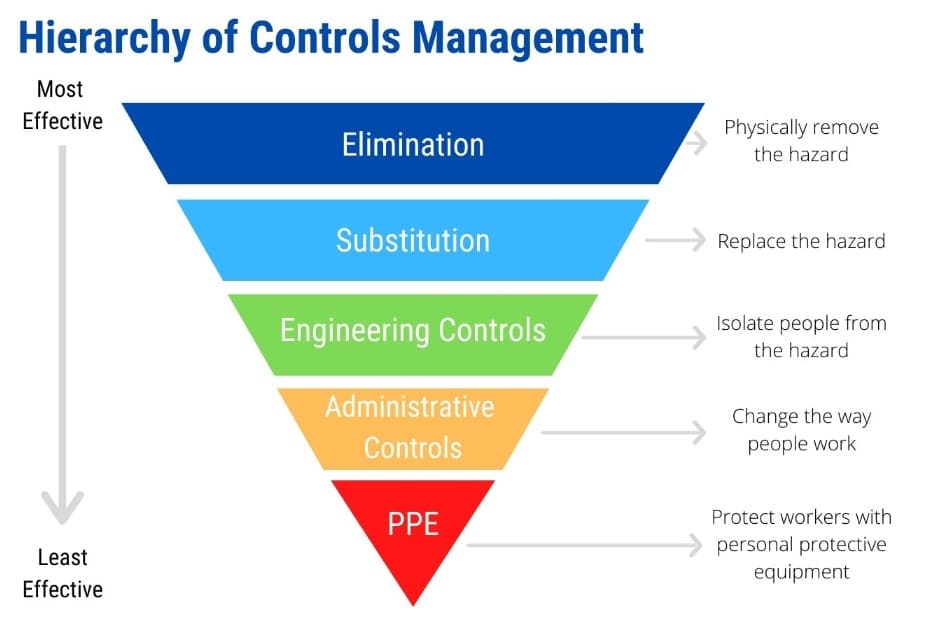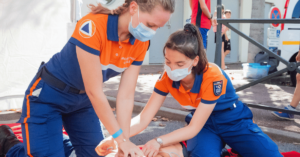We’ve heard a lot about PPE over the last few years, and when it comes to your business, it could form an integral part of your health and safety strategy for your team.
Depending on the sector you work in, PPE can help to protect your workforce, and prevent work-related injuries.
Key Points:
- PPE stands for ‘personal protective equipment’. It’s used in a variety of settings to minimise the risk of injury or illness to workers.
- There are a few types of PPE, including PPE for the head (e.g. helmets), body (e.g. hazmat suits), eyes (e.g. safety glasses). skin (e.g. gloves), respiratory system (e.g. RPE)
- Your employees should be wearing PPE when it’s appropriate; you could find yourself paying hefty fines for work-related injuries if they don’t.

What is PPE and what does it stand for?
PPE stands for ‘personal protective equipment‘.
It’s used in various settings to minimise the risk of injury or illness to workers. PPE could include things like masks, helmets, eye protection, or gloves.
Who should use PPE?
If any of your employees are at risk of exposure to harmful substances or working in an environment that could put them in danger, you should consider using PPE.
Take into consideration what your team are being exposed to, and how long they’ll be exposed to it, to determine what type of PPE they should be wearing.
It’s important for your employees to understand why they’re wearing PPE too, so have those conversations to encourage your colleagues to wear suitable PPE while they’re working.
What are the types of PPE?
There are a few types of PPE, including PPE for the:
- Head (e.g. helmets)
- Body (e.g. hazmat suits)
- Eyes (e.g. safety glasses)
- Skin (e.g. gloves)
- Respiratory system (e.g. RPE)
The PPE you wear will depend on your job, and the environment you’re working in.
What is the legislation for PPE?
There are two elements of the PPE regulations which are described on the HSE’s website as follows:
“The current legislation which relates to the use of personal protective equipment is the Personal Protective Equipment at Work Regulations 1992 . The latest details are available on legislation.gov.uk. Other special regulations cover hazardous substances (including lead and asbestos), and also noise and radiation.”
The 1992 regulations state that as an employer, you must provide PPE to employees only where there is a health and safety risk that cannot be suitably controlled by other means.
The regulations also state that the provision of the PPE should be:
- Suitably assessed to make sure that it is fit for the purpose that it is intended for
- Maintained and stored properly
- The user is trained and provided with instructions on how to use the PPE/RPE safely
- Used correctly by the employee
Although PPE can be an obvious solution to hazard control, you should also take into consideration other options, and build PPE into the overall strategy.
If we think of health and safety being a business argument as much as it is moral and legal, it’s key to look at the bigger picture, rather than relying on PPE to solve all of our hazard issues.
If we don’t spend the time carrying out a risk assessment properly across the board, we may miss opportunities to streamline processes and make ourselves more competitive, safer, and productive.
What are the risks of not using PPE?
If you’ve deemed PPE as a suitable requirement in your workplace, it could help to save your employees from injuries like chemical burns, head traumas, and electrocution.
Your employees should be wearing PPE when it’s appropriate; you could find yourself paying hefty fines for work-related injuries if they don’t.
It is important to remember that PPE is just one part of an overall health and safety strategy that should protect your workforce. You may bring other safety measures in that can help to reduce risks in your business too.
The disadvantages of PPE
PPE is the least effective way to control risk because of the high potential for damage to render PPE ineffective.
Additionally, some PPE, such as respirators, increase physiological effort to complete a task and, therefore, may require medical examinations to ensure workers can use the PPE without risking their health.
PPE is, without a doubt, a critical component of managing health and safety in the workplace.
By providing workers with an extra layer of protection, organisations can reduce the risk of injury or illness and create a safer work environment for all employees.
It is important to note that PPE should be used in conjunction with other control measures as part of the hierarchy of controls, such as administrative controls and engineering controls, to ensure the most comprehensive protection for workers.
Hierarchy of Controls Management
By using the hierarchy of controls when we assess risk, we can prioritise what controls we should consider and in what order.
In doing this, we are naturally interrogating the process and finding the right solution to control the appropriate risks. Or we may find that in fact, we are using the appropriate measures:

How to assess risk in your workplace
Start by looking at what you do and how you do it. Refer to your current risk assessments and see what you have in place already. Then, speak to everyone involved about the reality of the process – does it work and is the PPE provided effective?
From there, you are in a better position to answer the following questions:
- Are we doing enough to protect employees?
- Do we need to do more?
Once these questions are answered, you can establish what options you have left – and then use the hierarchy of control to provide some priority.








